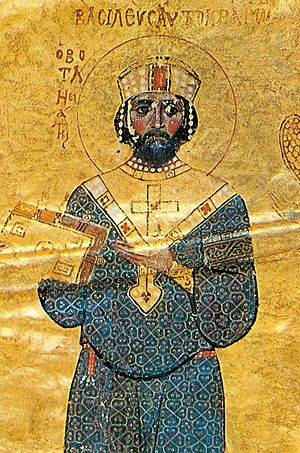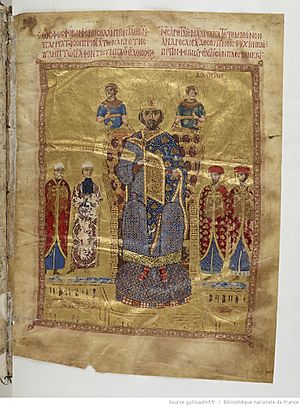Nikephoros III Botaneiates facts for kids
Quick facts for kids Nikephoros III Botaneiates |
|
|---|---|
| Emperor and Autocrat of the Romans | |
 |
|
| Byzantine Emperor | |
| Reign | 7 January 1078 – 1 April 1081 |
| Coronation | 3 April 1078 |
| Predecessor | Michael VII Doukas |
| Successor | Alexios I Komnenos |
| Born | 1002 |
| Died | 1081 Monastery of Peribleptus, Constantinople (now Istanbul, Turkey) |
| Wife |
|
| Father | Michael Botaneiates |
| Religion | Eastern Orthodox |
Nikephoros III Botaneiates (born 1002, died 1081) was a Byzantine Emperor. He ruled from January 7, 1078, to April 1, 1081. Before becoming emperor, Nikephoros was a skilled general. He served under several emperors and gained a reputation for his military abilities. His family was also well-known and respected.
Contents
Becoming Emperor
A General's Rise
Nikephoros was born in 1002 into the Botaneiates family. They were a famous military family from the Anatolic Theme, a region in the Byzantine Empire. His grandfather and father were also commanders. This family connection helped Nikephoros gain respect later in his life.
Nikephoros first became known for his actions during the Pecheneg revolt (1048–1053). After a battle, he bravely led his troops away from the enemy. He kept them in a tight formation for eleven days, even under constant attacks. His leadership saved his soldiers, and for this, Emperor Constantine IX Monomachos gave him a high honor.
He also played a role in the revolt of Isaac I Komnenos against Emperor Michael VI Bringas in 1057. Nikephoros led a part of Isaac's army in the important Battle of Petroe. This battle helped the military leaders regain power in the empire.
Later, under Emperor Constantine X Doukas, Nikephoros was made governor of Thessalonica. He helped settle disputes there, showing his fairness and wisdom. He also served as governor of Antioch, where he successfully defended the city from many attacks.
From Retirement to Rebellion
After Emperor Constantine X died, his wife, Empress Eudokia Makrembolitissa, thought about marrying Nikephoros and making him emperor. But she chose Romanos IV Diogenes instead. Romanos then sent Nikephoros away to his lands.
Years later, Emperor Michael VII Doukas called Nikephoros out of retirement. Even though Nikephoros was in his early seventies, Michael made him governor of the Anatolic Theme. This showed how much Michael trusted Nikephoros's military skills.
In 1077, Nikephoros saw how bad things were getting in the Byzantine Empire. He wrote to Emperor Michael, asking him to fix the problems. Michael was offended by Nikephoros's directness. To protect himself, Nikephoros gathered an army and declared himself emperor in July or October 1077.
Many people supported Nikephoros because of his military experience and his family's good name. On January 7, 1078, the Byzantine Senate officially recognized him as emperor. Michael VII then stepped down, and Nikephoros entered Constantinople on April 3, 1078, taking the throne.
Nikephoros's Reign
As emperor, Nikephoros faced many challenges. He had to deal with several revolts and plots against him.
Dealing with Rebellions
- Nikephoros Bryennios: Another general, also named Nikephoros Bryennios, had also tried to become emperor. Nikephoros III sent Alexios I Komnenos to defeat him. After Bryennios was defeated, Nikephoros III had him blinded but showed mercy to his followers.
- Nikephoros Basilakes: A supporter of Bryennios, Nikephoros Basilakes, also rebelled. Alexios quickly defeated him, and he was also blinded.
- Varangian Guard Plot: The Varangian Guard, the emperor's personal bodyguards, tried to kill Nikephoros during an inspection. But Nikephoros defended himself until his guards arrived. He sent the plot leaders away but forgave the rest.
- Constantine Doukas: Even though Nikephoros had been kind to him, Constantine Doukas plotted against the emperor. Nikephoros was popular enough that Constantine's rebellion didn't gain much support. Nikephoros offered amnesty to Constantine's soldiers, who then handed him over. Constantine was sent to a monastery.
- Paulician Revolts: Some groups, like the Paulicians, tried to use the chaos to rebel. Nikephoros quickly gathered an army. The rebels, seeing his strength, begged for forgiveness. Nikephoros showed mercy, giving them gifts and titles instead of punishment.
Reforms and Diplomacy
Nikephoros wanted to gain the support of the people since he had taken the throne by force.
- He spent a lot of money on gifts for his army and supporters.
- He returned gold and silver items that the previous emperor had taken from churches.
- He forgave all old debts, which helped many people who were struggling financially.
- He made some minor legal changes, like giving more time between sentencing and execution. He also worked to make the courts fairer.
Nikephoros also tried to improve the empire's situation through diplomacy. The Seljuk Turks were taking over Byzantine lands in Anatolia. Some governors, like Theodore Gabras and Philaretos Brachamios, had become almost independent. Nikephoros successfully negotiated with Philaretos, bringing his region back under Byzantine control. This helped Nikephoros gain more respect.
The End of His Reign
In 1081, Robert Guiscard, a Norman Duke, planned to invade the Byzantine Empire. He claimed he was defending the rights of Constantine Doukas, who was engaged to his daughter.
Alexios I Komnenos was given an army to fight the Normans. But Alexios, along with his relative John Doukas, decided to take the throne for himself. Alexios quickly led a rebellion against Nikephoros and surrounded Constantinople.
Nikephoros couldn't get help from his rivals, the Seljuk Turks or Nikephoros Melissenos. He realized he had to step down. He wanted to abdicate in favor of Melissenos, but Alexios's general intercepted his messengers.
On April 1, 1081, Alexios and his forces broke through the walls of Constantinople. Nikephoros fled to the Hagia Sophia for safety. He was then taken to the Monastery of Peribleptus, where he officially gave up his throne and became a monk. He died later that same year.
Images for kids
See also
 In Spanish: Nicéforo III para niños
In Spanish: Nicéforo III para niños





